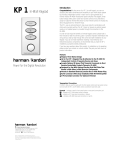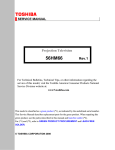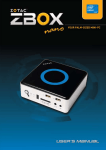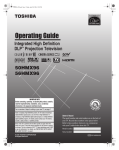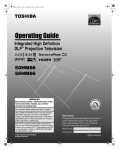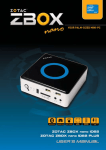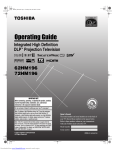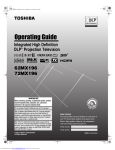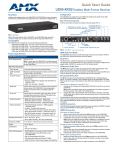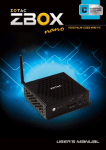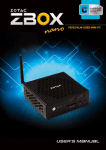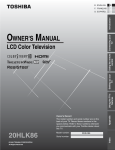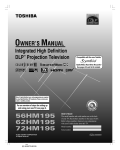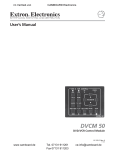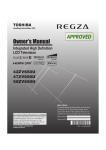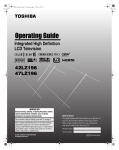Download User`s Manual
Transcript
DLP_Inst.book Page 1 Wednesday, February 22, 2006 6:18 PM Integrated High Definition DLP™ Projection Television 62MX196 72MX196 62MZ196 72MZ196 © 2006 TOSHIBA CORPORATION All Rights Reserved 140 45 IS O CONSUMER PR CA RI S, L.L.C. UCT OD TOSHIBA AM E 50HM66 56HM66 50HMX96 56HMX96 62HM196 72HM196 01 FILE N o. A 9 6 YC/N VX1A00004000 DLP_Inst.book Page 2 Wednesday, February 22, 2006 6:18 PM Dear Customer, NOTICE OF POSSIBLE TV STAND INSTABILITY Thank you for purchasing this Toshiba TV. This manual will help you use the many exciting features of your new TV. Before operating the TV, please read this manual completely, and keep it nearby for future reference. CAUTION: This television is for use only with the Toshiba stand listed in the “Specifications” section in the Operating Guide. Use with other carts or stands is capable of resulting in instability causing possible injury. Safety Precautions WARNING: TO REDUCE THE RISK OF FIRE OR ELECTRIC SHOCK, DO NOT EXPOSE THIS APPLIANCE TO RAIN OR MOISTURE. WARNING RISK OF ELECTRIC SHOCK DO NOT OPEN. WARNING: TO REDUCE THE RISK OF ELECTRIC SHOCK, DO NOT REMOVE COVER (OR BACK). NO USERSERVICEABLE PARTS INSIDE. REFER SERVICING TO QUALIFIED SERVICE PERSONNEL. (This does not apply to “Lamp unit replacement and care” in the Operating Guide.) The lightning flash with arrowhead symbol, within an equilateral triangle, is intended to alert the user to the presence of uninsulated “dangerous voltage” within the product’s enclosure that may be of sufficient magnitude to constitute a risk of electric shock to persons. The exclamation point within an equilateral triangle is intended to alert the user to the presence of important operating and maintenance (servicing) instructions in the literature accompanying the appliance. NOTE TO CATV INSTALLERS IN THE U.S.A. This is a reminder to call the CATV system installer’s attention to Article 820-40 of the U.S. NEC, which provides guidelines for proper grounding and, in particular, specifies that the cable ground shall be connected to the grounding system of the building, as close to the point of cable entry as practical. For additional antenna grounding information, see items 27 and 28 on page 4. Child Safety It Makes A Difference Where Your TV Stands Congratulations on your purchase! As you enjoy your new TV, keep these safety tips in mind: The Issue a If you are like most consumers, you have a TV in your home. Many homes, in fact, have more than one TV. a The home theater entertainment experience is a growing trend, and larger TVs are popular purchases; however, they are not always supported on the proper TV stands. a Sometimes TVs are improperly secured or inappropriately situated on dressers, bookcases, shelves, desks, audio speakers, chests, or carts. As a result, TVs may fall over, causing unnecessary injury. Lamp Unit Replacement Toshiba Cares! a The consumer electronics industry is committed to making home entertainment enjoyable and safe. a The Consumer Electronics Association formed the Home Entertainment Support Safety Committee, comprised of TV and consumer electronics furniture manufacturers, to advocate children’s safety and educate consumers and their families about television safety. The lamp in this product has a limited service life. The length of service life varies depending on product use and user settings. If you use the lamp beyond its service life: • you may notice a reduction in the colors and/or brightness of the picture, at which time you should replace the lamp unit; and • the strength of the quartz glass in the lamp will be reduced and the lamp may rupture. If the lamp ruptures, the TV will not operate until the lamp unit is replaced. Dispose of the used lamp unit by the approved method for your area. See “Lamp unit replacement and care” in the Operating Guide. Note: The lamp unit contains mercury. Disposal of mercury may be regulated due to environmental considerations. For disposal or recycling information, contact your local authorities or the Electronic Industries Alliance (www.eiae.org). Tune Into Safety a a a a a a a One size does NOT fit all! Use appropriate furniture large enough to support the weight of your TV (and other electronic components). Use appropriate angle braces, straps, and anchors to secure your furniture to the wall (but never screw anything directly into the TV). Carefully read and understand the other enclosed instructions for proper use of this product. Do not allow children to climb on or play with furniture and TVs. Avoid placing any item on top of your TV (such as a VCR, remote control, or toy) that a curious child may reach for. Remember that children can become excited while watching a program and can potentially push or pull a TV over. Share our safety message about this hidden hazard of the home with your family and friends. Thank you! 2500 Wilson Blvd. Arlington, VA 22201 U.S.A. Tel. 703-907-7600 Fax 703-907-7690 www.CE.org CEA is the Sponsor, Producer and Manager of the International CES ® 2 DLP Inst (E/F) Web 213:276 DLP_Inst.book Page 3 Wednesday, February 22, 2006 6:18 PM Important Safety Instructions 1) Read these instructions. 2) 3) 4) Keep these instructions. Heed all warnings. Follow all instructions. 5) Do not use this apparatus near water. 6) Clean only with dry cloth. 7) Do not block any ventilation openings. Install in accordance with the manufacturer’s instructions. 8) Do not install near any heat sources such as radiators, heat registers, stoves, or other apparatus (including amplifiers) that produce heat. 9) Do not defeat the safety purpose of Wide blade the polarized or grounding type plug. A polarized plug has two blades with one wider than the other. A grounding type plug has two blades and a third grounding prong. The wide blade or the third prong are provided for your safety. If the provided plug does not fit into your outlet, consult an electrician for replacement of the obsolete outlet. 10) Protect the power cord from being walked on or pinched, particularly at plugs, convenience receptacles, and the point where they exit from the apparatus. 11) Only use attachments/accessories specified by the manufacturer. 12) Use only with the cart, stand, tripod, bracket, or table specified by the manufacturer, or sold with the apparatus. When a cart is used, use caution when moving the cart/apparatus combination to avoid injury from tip-over. 13) Unplug this apparatus during lightning storms or when unused for long periods of time. 14) Refer all servicing to qualified service personnel. Servicing is required when the apparatus has been damaged in any way, such as power-supply cord or plug is damaged, liquid has been spilled or objects have fallen into the apparatus, the apparatus has been exposed to rain or moisture, does not operate normally, or has been dropped. Additional Safety Precautions 14a) Item 14 does not apply to “Lamp unit replacement and care” in the Operating Guide. 14b) CAUTION: If the TV is dropped and the cabinet or enclosure surface has been damaged or the TV does not operate normally, take the following precautions: • ALWAYS turn off the TV and unplug the power cord to avoid possible electric shock or fire. • To prevent personal injury, never handle the damaged television. • ALWAYS contact a service technician to inspect the TV any time it has been damaged or dropped. 15) CAUTION: • To reduce the risk of electric shock, do not use the polarized plug with an extension cord, receptacle, or other outlet unless the blades can be inserted completely to prevent blade exposure. • To prevent electric shock, match wide blade of plug to wide slot; fully insert. 16) WARNING: This product contains a lamp to project the picture, and requires special safety precautions: • See the Operating Guide for instructions on lamp unit replacement and care. • DO NOT attempt to service this product except as specified in the “Lamp unit replacement and care” section in the Operating Guide. The only userserviceable item in this product is the lamp unit. Installation, Care, and Service Installation Follow these recommendations and precautions and heed all warnings when installing your TV: 17) Never modify this equipment. Changes or modifications may void: a) the warranty, and b) the user’s authority to operate this equipment under the rules of the Federal Communications Commission. 18) DANGER: RISK OF SERIOUS PERSONAL INJURY, DEATH, OR EQUIPMENT DAMAGE! Never place the TV on an unstable cart, stand, or table. The TV may fall, causing serious personal injury, death, or serious damage to the TV. 19) Never place or store the TV in direct sunlight; areas subject to excessive dust or vibration; or locations with temperatures at or below 41°F (5°C). See “Specifications” section in the Operating Guide on operating conditions. 20) Always place the TV on the applicable optional TV stand(s) listed in the “Specifications” section in the Operating Guide (if available for this TV model) or on a sturdy, level, stable surface that can safely support the size and weight of the unit. See “Notice of possible TV stand instability” and “Child Safety” on page 2. 21) The apparatus shall not be exposed to dripping or splashing and that no objects filled with liquids, such as vases, shall be placed on the apparatus. 22) Always place the back of the television at least one (1) inch away from any vertical surface (such as a wall) to allow proper ventilation. 23) Never block or cover the slots or openings in the TV cabinet back, bottom, and sides. Never place the TV: • on a bed, sofa, rug, or similar surface; • too close to drapes, curtains, or walls; or • in a confined space such as a bookcase, built-in cabinet, or any other place with poor ventilation. The slots and openings are provided to protect the TV from overheating and to help maintain reliable operation of the TV. 3 DLP Inst (E/F) Web 213:276 DLP_Inst.book Page 4 Wednesday, February 22, 2006 6:18 PM 24) Never allow anything to rest on or roll over the power cord, and never place the TV where the power cord is subject to wear or abuse. 25) Never overload wall outlets and extension cords. 26) Always operate this equipment from a 120 VAC, 60 Hz power source only. 27) Always make sure the antenna system is properly grounded to provide adequate protection against voltage surges and built-up static charges (see Section 810 of the National Electric Code). Antenna lead-in wire Ground clamp Electric service equipment Ground clamps 28) Antenna discharge unit (NEC Section 810-20) Grounding conductors (NEC Section 810-21) Power service grounding electrode system (NEC Art 250 Part-H) DANGER: RISK OF SERIOUS PERSONAL INJURY OR DEATH! • Use extreme care to make sure you are never in a position where your body (or any item you are in contact with, such as a ladder or screwdriver) can accidentally touch overhead power lines. Never locate the antenna near overhead power lines or other electrical circuits. • Never attempt to install any of the following during lightning activity: a) an antenna system; or b) cables, wires, or any home theater component connected to an antenna or phone system. 34) During normal use, the TV may make occasional snapping or popping sounds. This is normal, especially when the unit is being turned on or off. If these sounds become frequent or continuous, unplug the power cord and contact a Toshiba Authorized Service Center. 35) Special care for DLP™ (Digital Light Processing) units: • The lamp unit in this product has a limited service life. The length of service life varies depending on product use or user settings. If you use the lamp beyond its service life: • you may notice a reduction in the colors and/or brightness of the picture, at which time you should replace the lamp unit; and • the strength of the quartz glass in the lamp will be reduced and the lamp may rupture. If the lamp ruptures, the TV will not operate until the lamp unit is replaced. See “Lamp unit replacement and care” in the Operating Guide. • Dispose of the used lamp unit by the approved method for your area. • The lamp unit contains mercury. Disposal of mercury may be regulated due to environmental considerations. For disposal or recycling information, please contact your local authorities or the Electronic Industries Alliance (www.eiae.org). Service 36) WARNING: RISK OF ELECTRIC SHOCK! Care For better performance and safer operation of your TOSHIBA TV, follow these recommendations and precautions: 29) Always sit approximately 10–25 feet away from the TV and as directly in front of it as possible. The picture can appear dull if you sit too far to the left or right of the TV, or if sunlight or room lights reflect on the screen. Turn the TV off to check for reflections on the screen, and then remove the source of reflections while viewing the TV. 30) Always unplug the TV before cleaning. Never use liquid or aerosol cleaners. Clean only with a soft, dry cloth. Do not spray volatile compounds, such as insecticide, on the cabinet. This may discolor or damage the cabinet. 31) 33) For added protection of your TV from lightning and power surges, always unplug the power cord and disconnect the antenna from the TV if you leave the TV unattended or unused for long periods of time. WARNING: RISK OF ELECTRIC SHOCK! Never spill liquids or push objects of any kind into the TV cabinet slots. 32) If the air temperature rises suddenly (for example, when the TV is first delivered), condensation may form on the lenses. This can make the picture appear distorted or the color appear faded. If this happens, turn off the TV for 6 to 7 hours to allow the condensation to evaporate. Never attempt to service the TV yourself, except as specified in the “Lamp unit replacement and care” section in the Operating Guide. Opening and removing the covers may expose you to dangerous voltage or other hazards. Failure to follow this WARNING may result in death or serious injury. Refer all servicing not specified in this manual to a Toshiba Authorized Service Center. 37) If you have the TV serviced: • Ask the service technician to use only replacement parts specified by the manufacturer. • Upon completion of service, ask the service technician to perform routine safety checks to determine that the TV is in safe operating condition. 38) When the TV reaches the end of its useful life, ask a qualified service technician to properly dispose of the TV. Note: The lamp unit contains mercury. Disposal of mercury may be regulated due to environmental considerations. Dispose of the used lamp unit by the approved method for your area. For disposal or recycling information, please contact your local authorities or the Electronic Industries Alliance (www.eiae.org). Digital Light Processing™, DLP™ and the DLP™ medallion are trademarks of Texas Instruments. 4 DLP Inst (E/F) Web 213:276 DLP_Inst.book Page 5 Wednesday, February 22, 2006 6:18 PM Welcome to Toshiba Thank you for purchasing this Toshiba TV, one of the most innovative DLP™ projection TVs on the market. This digital television is capable of receiving analog basic, digital basic and digital premium cable television programming by direct connection to a cable system providing such programming. A security card provided by your cable operator is required to view encrypted digital programming. Certain advanced and interactive digital cable services such as video-on-demand, a cable operator's enhanced program guide and data-enhanced television services may require the use of a set-top box. For more information call your local cable operator. We have provided three separate Guides to facilitate the installation and operation of your TV. Please use the Guides in the order shown below to get the most enjoyment from your new TV. 1) The “Installation Guide” explains how to connect your TV to your antenna and equipment. 2) The “Operating Guide” provides step-by-step instructions for using your TV’s many features. 3) The “TV Guide On Screen™ Interactive Program Guide” explains how to set up and navigate the TV Guide On Screen™ system in your TV. Notes: • Models 50HM66 and 56HM66 do not have the TV Guide On Screen™ feature; therefore, the TV Guide On Screen™ Interactive Program Guide is not provided in the accessory pack. • Screen captures provided in this Installation Guide may not match the screens that you see on your TV. Please refer to your Operating Guide. Terminal Specifications for DLP™ Projection Televisions This Installation Guide includes installation instructions for several television models. Please confirm your TV’s terminal specifications in the following table to determine which connection in this Guide is appropriate for your particular TV. Note: The model number is on the back of your TV. Input/Output Terminals RF Input Video/Audio Input (composite video/analog audio) 50/56HM66 62/72HM196 50/56HMX96 62/72MX196 62/72MZ196 Yes (2) Yes (2) Yes (2) Yes (2) Yes (2) Yes (2 sets) Yes (2 sets) Yes (2 sets) Yes (2 sets) Yes (2 sets) S-Video Input Yes (2 sets) Yes (2 sets) Yes (2 sets) Yes (2 sets) Yes (2 sets) ColorStream HD Input Yes (2 sets) Yes (2 sets) Yes (2 sets) Yes (2 sets) Yes (2 sets) Yes (2) Yes (2) Yes (2) Yes (2) Yes (2) PC Input No No Yes Yes Yes Video/Audio Output (composite video/analog audio) Yes Yes Yes Yes Yes Variable Audio Output (analog) Yes Yes Yes Yes Yes Digital Audio Output (optical) Yes Yes Yes Yes Yes Ethernet No Yes Yes Yes Yes IR In No No No No Yes IR Out (pass-through) Yes Yes Yes Yes Yes G-LINK™ No Yes Yes Yes Yes CableCARD™ Slot Yes Yes Yes Yes Yes TV Guide On Screen™ System No Yes Yes Yes Yes HDMI Input 5 DLP Inst (E/F) Web 213:276 DLP_Inst.book Page 6 Wednesday, February 22, 2006 6:18 PM Contents Important Safety Instructions . . . . . . . . . . . . . . . .3 Installation, Care, and Service . . . . . . . . . . . . . . .3 Welcome to Toshiba . . . . . . . . . . . . . . . . . . . . . .5 Terminal Specifications for DLP™ Projection Televisions . . . . . . . . . . . . . . . . . . . . . . . . . .5 Connecting your TV . . . . . . . . . . . . . . . . . . . . . . .7 Overview of cable types . . . . . . . . . . . . . . . . . . . . . . . . . . 7 About the connection illustrations . . . . . . . . . . . . . . . . . . 8 Connecting a digital CableCARD™. . . . . . . . . . . . . . . . . 8 Connecting a VCR and antenna or Cable TV (no Cable box) . . . . . . . . . . . . . . . . . . . . . . . . . . . . . . 9 Connecting a VCR and Cable box . . . . . . . . . . . . . . . . . 10 Connecting a DVD player with ColorStream® (component video), a VCR, and a satellite receiver . . . . . . . . . . . . . . . . . . . . . . . . . . . . . . . . . . . 11 Connecting a VCR with S-video and a cable box . . . . . 12 Connecting an HDMI™ or DVI device to the HDMI input . . . . . . . . . . . . . . . . . . . . . . . . . . . . . . . 13 Connecting a device to the IR OUT infrared terminal using the IR blaster cable for IR pass-through device control . . . . . . . . . . . . . . . . . . . . . . . . . . . . . . 14 Connecting an IR receiver/repeater control system to the IR IN infrared terminal . . . . . . . . . . . . . . . . . . . . 15 Connecting a camcorder . . . . . . . . . . . . . . . . . . . . . . . . . 15 Connnecting a digital audio system . . . . . . . . . . . . . . . . 16 Connecting an analog audio system . . . . . . . . . . . . . . . . 16 G-LINK™ connection . . . . . . . . . . . . . . . . . . . . . . . . . . 17 Connecting a personal computer (PC) . . . . . . . . . . . . . . 18 Connecting a home network . . . . . . . . . . . . . . . . . . . . . . 19 Index . . . . . . . . . . . . . . . . . . . . . . . . . . . . . . . . 21 6 DLP Inst (E/F) Web 213:276 DLP_Inst.book Page 7 Wednesday, February 22, 2006 6:18 PM Connecting your TV Overview of cable types both video and audio information; therefore, separate audio cables are not required for a complete HDMI device connection (- page 13). Coaxial (F-type) cable Note: HDMI cable provides better picture performance than a standard (composite) video or S-video cable. Coaxial (F-type) cable is used for connecting your antenna, cable TV service, and/or cable converter box to the ANT 1 and/or ANT 2 RF inputs on your TV. Standard A/V cables (red/white/yellow) Standard A/V cables (composite video) usually come in sets of three, and are for use with video devices with analog audio and composite video output. These cables (and the related inputs on your TV) are typically color-coded according to use: yellow for video, red for stereo right audio, and white for stereo left (or mono) audio. S-video cable S-video cable is for use with video devices with S-video output. Separate audio cables are required for a complete connection. Note: An S-video cable provides better picture performance than a composite video cable. If you connect an S-video cable, be sure to disconnect the standard (composite) video cable or the picture performance will be unacceptable. Component video cables (red/green/blue) Dual-wand IR blaster/G-LINK™ cable Dual-wand IR blaster/G-LINK™ cable is for use with video devices with IR (infrared) remote control. This cable is for connection to the G-LINK™ terminal (- page 17) to enable TV Guide On Screen™ recording features (- TV Guide On Screen™ Interactive Program Guide). This cable also can be used with the TV’s IR pass-through feature (- page 14). Notes: • This applies only to TV models that have the TV Guide On Screen™ feature. To verify whether your TV model has this feature, see the table on page 5. • The IR blaster/G-LINK™ cable included with your TV have specific characteristics that allow them to work properly with this TV’s IR OUT and G-LINK™ ports. Never use other aftermarket IR blaster or G-LINK™ cables with this TV. Other cables may not function properly and can cause damage. THIS TYPE OF DAMAGE IS NOT COVERED BY YOUR TOSHIBA WARRANTY. Optical audio cable Optical audio cable is for connecting receivers with Dolby Digital or PCM (pulse-code modulation) optical audio input to the TV’s DIGITAL AUDIO OUT terminal (- page 16). Analog RGB (15-pin) computer cable Component video cables come in sets of three and are for use with video devices with component video output. (ColorStream® is Toshiba’s brand of component video.) These cables are typically color-coded red, green, and blue. Separate audio cables are required for a complete connection. Note: Component video cables provide better picture performance than a standard (composite) video or S-video cable. HDMI™ cable Analog RGB (15-pin) computer cable is for connecting a PC to the TV’s PC IN terminal (- page 18). Ethernet (RJ-45) cable Ethernet (RJ-45) cable is used to connect the TV to your home network (- page 19 and the Operating Guide). HDMI (High-Definition Multimedia Interface) cable is for use with devices with an HDMI output. An HDMI cable delivers digital audio and video in its native format. This cable carries 7 DLP Inst (E/F) Web 213:276 DLP_Inst.book Page 8 Wednesday, February 22, 2006 6:18 PM Connecting your TV About the connection illustrations You can connect different types and brands of devices to your TV in several different configurations. The connection illustrations in this manual are representative of typical device connections only. The input/output terminals on your devices may differ from those illustrated herein. For details on connecting and using your specific devices, refer to each device’s owner’s manual. 2 With the front of the CableCARD™ facing up, insert it into the CableCARD™ slot on the back of the TV (see illustration below left). 3 After the CableCARD™ is inserted, a CableCARD™ option appears in the Applications menu, with informational screens provided by your digital CableCARD™ service. See “Viewing the CableCARD™ menu” in the Operating Guide for additional information. CableCard Connected -- Acquiring channel information. Applications CableCard services will only operate with cable signal connected to Antenna 1. Connecting a digital CableCARD™ This digital television is capable of receiving analog basic, digital basic, and digital premium cable television programming by direct connection to a cable system providing such programming. A security card (such as a digital CableCARD™), provided by your cable operator, is required to view encrypted digital programming. Certain advanced and interactive digital cable services (such as video-on-demand, a cable operator’s enhanced program guide, and data-enhanced television services) will not work with the use of a CableCARD™ and may require the use of a separate set-top box from your cable operator. For more information, contact your local cable operator. You will need: • digital CableCARD™ (contact your cable operator) • digital cable subscription service (contact your cable operator) TV back panel From digital Cable service To view encrypted digital channels: 1 Connect your digital Cable TV cable to ANT 1. Channel Browser Digital CC/Audio Selector CableCARD IP Service Conditional Access CableCARD(tm) Status Network Setup CableCARD(tm) Pairing Navigate ENTER Select CH RTN Back EXIT Exit Notes: • Connect the cable from your digital cable TV service directly to ANT 1 only. If you connect the digital cable through a VCR first and/or to ANT 2, the TV may not receive the signals correctly. • Always use the EJECT button to remove the CableCARD™. Removing the CableCARD™ without pressing EJECT can damage the CableCARD™ and/or TV. Such damage is NOT covered under your Toshiba warranty. • Never insert any object or card other than a CableCARD™ (including, without limitation, a PCMCIA card) into the CableCARD™ slot. • Always make sure the CableCARD™ is facing the correct direction. • When using a CableCARD™, you do not need to program channels into the TV memory. The CableCARD™ automatically loads the cable channel list into the TV’s channel memory (- Operating Guide). • The CableCARD™ may take about 5 minutes to “pair” with the TV and download channel information. CableCARD™ information and channels will not be available until this process is completed. • Connecting your TV directly to the Audio/Video output of your Set-Top-Box will assure a more vivid picture and enhance your viewing enjoyment. CableCARD™ technology, like all new and emerging technology, may from time to time experience compatibility issues due to the different ways in which television manufacturers and cable system operators implement the CableCARD™ specifications. Most issues can be easily resolved. If you experience any performance-related CableCARD™ issues with your Toshiba television, please contact the following: In the U.S.: • Call TACP Consumer Solutions at (800) 631-3811 • Or visit http://www.tacp.com/customersupport/contact.asp. In Canada: • Call TCL Customer Service at 1-800-268-3404. CableCARD is a trademark of Cable Television Laboratories, Inc. 8 DLP Inst (E/F) Web 213:276 DLP_Inst.book Page 9 Wednesday, February 22, 2006 6:18 PM Connecting your TV Connecting a VCR and antenna or Cable TV (no Cable box) To use the TV Guide On Screen™ recording features (if applicable to your TV model): You will need: 2 • signal splitter • coaxial cables • standard A/V cables 1 3 – For better picture performance, if your VCR has S-video, use an S-video cable (plus the audio cables) instead of the standard video cable. Do not connect both types of video cable to VIDEO 1 at the same time or the picture performance will be unacceptable. – If you have a mono VCR, connect L/MONO on the TV to your VCR’s audio out terminal using the white audio cable only. Note: The VIDEO/AUDIO OUT terminals output signals from the ANT 1, ANT 2, VIDEO 1, and VIDEO 2 terminals when the applicable input mode is selected.* From Cable TV or antenna Signal splitter IN 4 Connect the G-LINK™ cable according to the instructions (- page 17). Make sure the VCR is connected to the VIDEO/ AUDIO OUT terminals on the TV (see illustration). Set the VCR to the appropriate line input (refer to your VCR owner’s manual for details), and then turn OFF the VCR. See the TV Guide On Screen™ Interactive Program Guide for details on setting up and using the TV Guide On Screen™ system. The unauthorized recording, use, distribution, or revision of television programs, videotapes, DVDs, and other materials is prohibited under the Copyright Laws of the United States and other countries, and may subject you to civil and criminal liability. In the United States, TV GUIDE and other related marks are registered marks of Gemstar-TV Guide International, Inc. and/or one of its affiliates. In Canada, TV GUIDE is a registered mark of Transcontinental Inc., and is used under license by Gemstar-TV Guide International, Inc. OUT OUT Stereo VCR VIDEO IN from ANT L AUDIO R IN IN CH 3 CH 4 OUT OUT to TV L R TV To view the antenna or Cable signal: Select the ANT 1 video input source on the TV.* To view the VCR: Turn ON the VCR. Select the VIDEO 1 video input source on the TV.* * To select the video input source, press INPUT on the remote control (- Operating Guide). To program the TV remote control to operate other devices, see the Operating Guide, Chapter 2. 9 DLP Inst (E/F) Web 213:276 DLP_Inst.book Page 10 Wednesday, February 22, 2006 6:18 PM Connecting your TV Connecting a VCR and Cable box You will need: To view the VCR: Turn ON the VCR. Select the VIDEO 1 video input source on the TV.* * To select the video input source, press INPUT on the remote control (- Operating Guide). To program the TV remote control to operate other devices, see the Operating Guide, Chapter 2. • signal splitter • coaxial cables • standard A/V cables – For better picture performance, if your VCR has S-video, connect an S-video cable (plus the audio cables) instead of the standard video cable. Do not connect both types of video cable to VIDEO 1 at the same time or the picture performance will be unacceptable. – If you have a mono VCR, connect L/MONO on the TV to your VCR’s audio out terminal using the white audio cable only. – When you use a Cable box, you may not be able to use the remote control to program or access certain features on the TV. Note: The VIDEO/AUDIO OUT terminals output signals from the ANT 1, ANT 2, VIDEO 1, and VIDEO 2 terminals when the appropriate input mode is selected.* To enable the TV Guide On Screen™ system to work with your cable box and to use the TV Guide On Screen™ recording features (if applicable to your TV model): 1 2 3 4 Connect the G-LINK™ cable according to the instructions (- page 17). Make sure the VCR is connected to the VIDEO/ AUDIO OUT terminals on the TV (see illustration). Set the VCR to the appropriate line input (refer to your VCR owner’s manual for details), and then turn OFF the VCR. See the TV Guide On Screen™ Interactive Program Guide for details on setting up and using the TV Guide On Screen™ system. From Cable TV Cable box Signal splitter IN OUT IN CH 3 CH 4 OUT OUT The unauthorized recording, use, distribution, or revision of television programs, videotapes, DVDs, and other materials is prohibited under the Copyright Laws of the United States and other countries, and may subject you to civil and criminal liability. Stereo VCR VIDEO IN from ANT L AUDIO R IN IN CH 3 CH 4 OUT OUT to TV L R TV To view basic Cable channels and use the TV’s features: Select the ANT 1 video input source on the TV.* Use the TV controls (control panel or remote control) to change channels and access the TV’s features. To view basic and premium Cable channels: Turn OFF the VCR. Select the ANT 2 video input source on the TV.* Tune the TV to channel 3 or 4 (whichever channel the Cable box output is set to). Use the Cable box controls to change channels. 10 DLP Inst (E/F) Web 213:276 DLP_Inst.book Page 11 Wednesday, February 22, 2006 6:18 PM Connecting your TV Connecting a DVD player with ColorStream® (component video), a VCR, and a satellite receiver From antenna Signal splitter IN OUT OUT Stereo VCR Your TV has two sets of ColorStream® (component video) inputs. VIDEO IN from ANT You will need: L AUDIO R IN IN CH 3 CH 4 OUT OUT to TV L • signal splitter • coaxial cables • standard A/V cables R TV – For better picture performance, if your VCR has S-video, use an S-video cable (plus the audio cables) instead of the standard video cable. Do not connect both types of video cable to VIDEO 1 at the same time or the picture performance will be unacceptable. – If you have a mono VCR, connect L/MONO on the TV to your VCR’s audio out terminal using the white audio cable only. • standard audio cables • component video cables – You can connect the component video cables (plus audio cables) from the DVD player or satellite receiver to either set of ColorStream terminals on the TV (HD-1 or HD-2). The ColorStream HD-1 and HD-2 terminals can be used with Progressive (480p, 720p) and Interlaced (480i, 1080i) scan systems. A 1080i signal will provide the best picture performance. – If your DVD player or satellite receiver does not have component video, connect an S-video cable (plus audio cables) to VIDEO 2 on the side panel. If your DVD player has HDMI video, see page 13. Note: The VIDEO/AUDIO OUT terminals output signals from the ANT 1, ANT 2, VIDEO 1, and VIDEO 2 terminals when the appropriate input mode is selected.* * To select the video input source, press INPUT on the remote control (- Operating Guide). To program the TV remote control to operate other devices, see the Operating Guide, Chapter 2. DVD player with component video AUDIO OUT Y S-VIDEO OUT L PR PB COMPONENT VIDEO VIDEO OUT R From satellite dish AUDIO OUT Y Satellite S-VIDEO IN OUT PB L PR COMPONENT VIDEO VIDEO OUT R Satellite receiver with component video To view antenna or Cable channels: Select the ANT 1 video input source on the TV.* To view the DVD player: Turn ON the DVD player. Select the ColorStream HD-1 video input source on the TV.* To view satellite programs using the component video connections or to record satellite programs: Turn on all three devices. Set the VCR to the appropriate line input (refer to your VCR owner’s manual for details). Select the ColorStream HD-2 video input source on the TV.* To view the VCR or view and record antenna channels: Turn ON the VCR. Tune the VCR to the channel you want to watch. Select the VIDEO 1 video input source on the TV.* (continued) 11 DLP Inst (E/F) Web 213:276 DLP_Inst.book Page 12 Wednesday, February 22, 2006 6:18 PM Connecting your TV To record a TV program while watching a DVD: Turn ON the VCR. Tune the VCR to the channel to record. Select the ColorStream HD-1 video input source on the TV* to view the DVD. * To select the video input source, press INPUT on the remote control (- Operating Guide). To program the TV remote control to operate other devices, see the Operating Guide, Chapter 2. To use the TV Guide On Screen™ recording features (if applicable to your TV model): 1 2 3 4 Connect the G-LINK™ cable according to the instructions (- page 17). Make sure the VCR is connected to the VIDEO/ AUDIO OUT terminals on the TV (see illustration). Set the VCR to the appropriate line input (refer to your VCR owner’s manual for details), and then turn OFF the VCR. See the TV Guide On Screen™ Interactive Program Guide for details on setting up and using the TV Guide On Screen™ system. Note: The TV Guide On Screen™ system does not receive program listings from or for any satellite service. Connecting a VCR with S-video and a cable box An S-video connection will provide better picture performance than a standard (composite) video cable. If your VCR does not have S-video, refer to the connection on page 10. You will need: • • • • • signal splitter coaxial cables standard A/V cables S-video cable standard audio cables Notes: • Do not connect both types of video cable to VIDEO 1 at the same time or the picture performance will be unacceptable. • See page 10 for details on the VCR and Cable box connection. From Cable TV Cable box IN OUT The unauthorized recording, use, distribution, or revision of television programs, videotapes, DVDs, and other materials is prohibited under the Copyright Laws of the United States and other countries, and may subject you to civil and criminal liability. Signal splitter IN CH 3 CH 4 OUT OUT Stereo VCR VIDEO IN from ANT L AUDIO R IN IN CH 3 CH 4 OUT OUT to TV L R TV 12 DLP Inst (E/F) Web 213:276 DLP_Inst.book Page 13 Tuesday, February 28, 2006 3:23 PM Connecting your TV Connecting an HDMI™ or DVI device to the HDMI input The HDMI input on your TV receives digital audio and uncompressed digital video from an HDMI source device, or uncompressed digital video from a DVI (Digital Visual Interface) source device. This input is designed to accept HDCP (High-Bandwidth Digital-Content Protection) program material in digital form from EIA/CEA-861-861B–compliant[1] consumer electronic devices (such as a set-top box or DVD player with HDMI or DVI output). The HDMI input is designed for best performance with 1080i signals but will also accept and display 480i, 480p and 720p signals. NOTE: DO NOT CONNECT A PC USING THE HDMI PORT. Always use the TV’s PC IN (VGA) port to connect a PC. To connect a DVI device, you will need: • one HDMI-to-DVI adapter cable (HDMI type A connector) per DVI device – For proper operation, the length of an HDMI-to-DVI adapter cable should not exceed 9.8 ft (3m). The recommended length is 6.6 ft (2m). • one pair of standard analog audio cables per DVI device – An HDMI-to-DVI adapter cable transfers video only. Separate analog audio cables are required (see illustration). – See “Setting the HDMI™ audio mode” in the Operating Guide. DVI device VIDEO L DVI/HDCP OUT AUDIO R IN IN OUT L R TV • The HDMI port is not designed to support input from a PC. • Only models that include a PC IN (VGA) port are suitable for connection to a PC. To connect an HDMI device, you will need: • one HDMI cable (type A connector) per HDMI device – For proper operation, it is recommended that you use as short an HDMI cable as possible. You should not encounter difficulty if you use an HDMI cable shorter than 16.4 ft (5m). – HDMI cable transfers both video and audio. Separate analog audio cables are not required (see illustration). – See “Setting the HDMI™ audio mode” in the Operating Guide. HDMI device VIDEO L AUDIO R HDMI OUT Note: To ensure that the HDMI or DVI device is reset properly, it is recommended that you follow these procedures: • When turning on your electronic components, turn on the TV first, and then the HDMI or DVI device. • When turning off your electronic components, turn off the HDMI or DVI device first, and then the TV. IN IN OUT L R TV [1] EIA/CEA-861-861B compliance covers the transmission of uncompressed digital video with high-bandwidth digital content protection, which is being standardized for reception of highdefinition video signals. Because this is an evolving technology, it is possible that some devices may not operate properly with the TV. HDMI, the HDMI logo and High-Definition Multimedia Interface are trademarks or registered trademarks of HDMI Licensing LLC. Note: If the audio output mode of the HDMI device is other than the PCM mode, the sound does not output from the TV’s speakers (models 50HM66 and 56HM66 only). 13 DLP Inst (E/F) Web 213:276 DLP_Inst.book Page 14 Wednesday, February 22, 2006 6:18 PM Connecting your TV Connecting a device to the IR OUT infrared terminal using the IR blaster cable for IR pass-through device control You can use the TV’s IR OUT terminal (infrared passthrough) to remotely operate –through the TV– many infrared remote-controlled devices (such as a Toshiba infrared remotecontrolled VCRs or DVD player) enclosed within an entertainment center or similar cabinet. Without the IR OUT connection, the device typically would need to be visible to operate it remotely. Note: If you do not have a second device, coil the second wand with a rubber band and leave it behind the TV. 3 Plug the IR blaster cable’s plug into the TV’s IR OUT terminals. To control the device(s): Point either the device's remote control or the TV remote control (that you previously programmed to operate the device; - Operating Guide, Chapter 2) toward the front of the TV and press the button for the desired function. The signal passes from the remote control through the TV to the device via the IR blaster cable. You will need: • dual-wand IR blaster cable • other audio/video cables as required to connect the device(s) to the TV (- pages 9–13) Front of IR-controlled DVD player (for example) Front of IR-controlled audio device (for example) Infrared sensor Notes: • If you use the device’s remote control to operate the device, you also will need to use the TV’s remote control to operate the TV. • The IR pass-through feature does not support all IRcontrolled devices; satisfactory performance may not be attainable with certain devices. *If you cannot locate the device’s infrared sensor: IR blaster cable wand (approx.1 inch from device) TV 1 2 3 4 5 Turn OFF the device. Starting at the lower left corner of the device, place the end of the device’s remote control (with the infrared emitter) so it touches the front of the device and press POWER. (Do not use the TV’s remote control for this step.) If the device turns on, the point at which the remote control touched the device is the location of the sensor. If the device does not turn on, move the remote control slightly to the right and press POWER again. Repeat step 4 until you locate the device’s infrared sensor. To connect the IR blaster cable: 1 Locate the infrared sensor on the front of your device. This sensor is marked on some devices.* 2 Align one of the IR blaster cable’s wands about 1 inch away from the infrared sensor on the front of the device and attach it using double-sided mounting tape. If you have a second device, attach the second wand in a similar manner. (See illustration.) 14 DLP Inst (E/F) Web 213:276 DLP_Inst.book Page 15 Wednesday, February 22, 2006 6:18 PM Connecting your TV Connecting an IR receiver/repeater control system to the IR IN infrared terminal For additional control options for your home theater system, you can connect an IR receiver/repeater control system (not included) to the TV’s IR IN terminal. You will need: Connecting a camcorder You will need: • standard A/V cables – For better picture performance, if your camcorder has S-video, use an S-video cable (plus the audio cables) instead of the standard video cable. Do not connect both types of video cable to VIDEO 2 at the same time or the picture performance will be unacceptable. • IR cable Camcorder TV VIDEO AUDIO OUT L R VIDEO 2 inputs on TV right side panel OUT IN To view the camcorder video: Select the VIDEO 2 video input source on the TV.* Back of IR receiver/repeater control system (not included) * To select the video input source, press INPUT on the remote control (- Operating Guide). To program the TV remote control to operate other devices, see the Operating Guide, Chapter 2. To operate the TV with this connection, point the Toshiba TV remote control toward the front of the IR receiver/repeater control system. IR receiver/repeater control system 15 DLP Inst (E/F) Web 213:276 DLP_Inst.book Page 16 Wednesday, February 22, 2006 6:18 PM Connecting your TV Connecting a digital audio system The TV’s DIGITAL AUDIO OUT terminal outputs a Dolby®* Digital g or 2-channel down-mixed PCM (pulse-code modulation) signal for use with an external Dolby® Digital decoder or other external audio system with optical audio input. You will need: • optical audio cable (Use an optical audio cable that has the larger “TosLink” connector and not the smaller “minioptical” connector.) Dolby Digital decoder or other digital audio system Turn off the TV’s built-in speakers in the same Audio Setup menu. Also see “Turning off the built-in speakers” in the Operating Guide. Notes: • Some audio systems may not be compatible with Dolby Digital bitstream signals. Older audio systems that are not compatible with standard optical out signals may not work properly, creating a high noise level that may damage speakers or headphones. THIS DAMAGE IS NOT COVERED BY YOUR WARRANTY. • The DIGITAL AUDIO OUT terminal outputs signals only when receiving digital broadcasts with the TV in singlewindow mode. • The DIGITAL AUDIO OUT terminal may not output some digital audio sources because of copy restrictions. * Manufactured under license from Dolby Laboratories. Dolby and the double-D symbol are registered trademarks of Dolby Laboratories. Optical Audio IN LINE IN L R 5 TV Connecting an analog audio system This connection allows you to use external speakers with an external analog audio amplifier to adjust the sound level. You will need: • standard audio cables Analog audio amplifier LINE IN L R To control the audio: 1 2 Turn on the TV and the digital audio device. 3 Highlight Audio Setup and press ENTER. Press MENU on the TV’s remote control and open the Audio menu. TV Audio Audio Settings Advanced Audio Settings Audio Setup 4 In the Optical Output Format field, select either Dolby Digital or PCM, depending on your device (- “Selecting the optical audio output format” in the Operating Guide). Audio Setup MTS Stereo Language English Speakers On Optical Output Format Reset Dolby Digital Done To control the audio: 1 2 Turn on the TV and the stereo amplifier. Turn off the TV’s built-in speakers (- “Turning off the built-in speakers” in the Operating Guide). Note: To hear sound when using an external audio amplifier, the volume of both the TV and the amplifier must be set to a reasonable listening level. 16 DLP Inst (E/F) Web 213:276 DLP_Inst.book Page 17 Wednesday, February 22, 2006 6:18 PM Connecting your TV Front of Cable box G-LINK™ connection Note: The G-LINK™ connection applies only to TV models that have the TV Guide On Screen™ feature. To verify whether your TV has this feature, see the table on page 5. This connection is necessary for the TV Guide On Screen™ system to work with your cable box to receive program listings and to enable the TV Guide On Screen™ recording features with your VCR. After you connect your devices to the TV, you will need to connect the G-LINK™ cable from your VCR and Cable box (if applicable) to the G-LINK™ terminal on the TV. Front of VCR Infrared sensor G-LINK™(IR blaster) cable wand (approx.1inch from device) TV Note: TV Guide On Screen™ program data is available through the ANT 1 and ANT 2 antenna inputs and also through the VIDEO 1 inputs if you have a cable box connected to VIDEO 1. TV Guide On Screen™ program data is not available through any other inputs on this TV (- pages 9–16). The G-LINK™ connection is necessary to enable the following features of your TV Guide On Screen™ system: • If you have a Cable box, you must connect the G-LINK™ cable from the Cable box to the G-LINK™ terminal to receive the TV Guide On Screen™ program listings for your Cable service. • If you have a VCR, you must connect the G-LINK™ cable from the VCR to the G-LINK™ terminal to use the TV Guide On Screen™ recording features. To connect to the G-LINK™ terminal: 1 2 3 Locate the infrared sensor on the front of your VCR or Cable box. The sensor is marked on some devices.* Align one of the G-LINK™ (IR blaster) cable’s wands about 1 inch away from the infrared sensor on the front of the VCR and attach it using double-sided mounting tape. If you have a Cable box, attach the other wand in a similar manner. (See illustration.) For details on setting up and using the TV Guide On Screen™ system: See the TV Guide On Screen™ Interactive Program Guide (included only with TV models that have the TV Guide On Screen™ system). *If you cannot locate the device’s infrared sensor: 1 2 Note: If you do not have a Cable box, coil the second wand with a rubber band and leave it behind the TV. 3 Plug the G-LINK™ (IR blaster) cable’s plug into the TV’s G-LINK™ terminal. 4 5 Turn OFF the device. Starting at the lower left corner of the device, place the end of the device’s remote control (with the infrared emitter) so it touches the front of the device and press POWER. (Do not use the TV’s remote control for this step.) If the device turns on, the point at which the remote control touched the device is the location of the sensor. If the device does not turn on, move the remote control slightly to the right and press POWER again. Repeat step 4 until you locate the device’s infrared sensor. 17 DLP Inst (E/F) Web 213:276 DLP_Inst.book Page 18 Wednesday, February 22, 2006 6:18 PM Connecting your TV Connecting a personal computer (PC) This connection allows you to view the image from a PC on the TV screen. When connecting a PC to the TV, use an analog RGB (15-pin) computer cable and a PC audio cable. Signal names for mini D-sub 15-pin connector Pin assignment for RGB/PC terminal 5 10 15 TV 1 6 11 Pin No. Computer PC audio cable PC audio output Conversion adapter (if necessary) • To use a PC, set the monitor output resolution on the PC before connecting it to the TV. The following signals can be displayed: – VGA: 640 5 480 @ 60Hz – SVGA: 800 5 600 @ 60Hz – XGA: 1024 5 768 @ 60Hz Signal name 1 2 R G 3 4 B NC (not connected) 5 6 NC Ground 7 8 9 10 Ground 11 12 NC NC 13 14 H-sync V-sync 15 NC Ground NC Ground Notes: • Some PC models cannot be connected to this TV. • An adapter is not needed for computers with a DOS/V compatible mini D-sub15-pin terminal. • Depending on the DVD’s title and the specifications of the PC on which you are playing the DVD-Video, some scenes may be skipped or you may not be able to pause during multi-angle scenes. • Only models that include a PC IN (VGA) port are suitable for connecting a PC. Never connect a PC to the HDMI port. Other formats or non-standard signals may not be displayed correctly. • To display the optimum picture, use the PC setting feature (- “Using the PC setting feature” in the Operating Guide). 18 DLP Inst (E/F) Web 213:276 DLP_Inst.book Page 19 Wednesday, February 22, 2006 6:18 PM Connecting your TV Connecting a home network The Toshiba Home Interactive Network Connection (THINC™) feature allows you to network the TV with your home PC (personal computer), which will allow access to the TV’s file sharing and e-mail scheduling features. File sharing Example #1: Connecting the TV to a home network without an Internet connection (for file sharing only) You will need: • standard Ethernet (RJ-45) cables (the number of cables depends on the number of PCs you connect to your network) • hub or switch TV back panel You can access JPEG and MP3 files that are stored on your networked home PC and view/play them on the TV. • Connect your TV to your PC /network according to either Example #1 or Example #2. • Does NOT require Internet/e-mail service. E-mail scheduling of recordings and reminders You can schedule recordings and reminders by sending an e-mail to the TV from any PC. (This connection also allows access to file sharing, as described above.) • Connect your TV to your home network according to Example #3 on the next page. • Requires the following: Hub or switch PC – Home Internet service. – A dedicated POP3 e-mail address for the TV (different from your personal e-mail address). – A compatible recording device. • Contact your ISP (Internet Service Provider) to obtain and set up Internet/e-mail service. • See the connection information for recording device connection instructions. • See the Operating Guide for details on configuring and using e-mail scheduling, file sharing, the JPEG Picture Viewer, and the MP3 Audio Player. Notes: • The TV’s home network feature is compatible only with Microsoft® Windows® 2000 and the Home or Professional version of Microsoft® Windows® XP Service Pack 1 and Service Pack 2. See Operating Guide for details. • The TV’s home network connection allows access to e-mail scheduling and file sharing only. You will NOT be able to use the TV to access the Internet. • If you use an Ethernet crossover cable to connect your PC directly to the TV, you will not be able to use the automatic setup and must manually set up the network address. • If you use a hub or switch to connect the TV to your home network, you will not be able to use the automatic setup and must manually set up the network address. • If you use a router with built-in DHCP functionality, use the automatic setup. Manual setup may not work. PC Example #2: Connecting the TV directly to a PC without an Internet connection (for file sharing only) You will need: • Ethernet crossover cable (i.e., a PC-to-PC direct file transfer cable) Note: Do not use standard Ethernet cable with this connection. TV back panel PC Ethernet crossover cable Microsoft and Windows are either registered trademarks or trademarks of Microsoft Corporation in the United States and/or other countries. (continued) 19 DLP Inst (E/F) Web 213:276 DLP_Inst.book Page 20 Wednesday, February 22, 2006 6:18 PM Connecting your TV Example #3: Connecting the TV to a home network with an Internet connection (for e-mail scheduling and file sharing) You will need: • • • • coaxial or telephone cable (depending on your modem) standard Ethernet (RJ-45) cables router/switch[1] modem (DSL or cable)[2] TV back panel Router/switch [1] Modem (DSL or cable) [2] [3] [3] Cable or phone jack [4] [3] PC [1] Your router/switch may be part of your DSL or cable modem. Your switch may be separate from your router. For assistance, contact your ISP or an IT professional. [2] Coaxial or telephone cable (depending on your modem type) [3] Standard Ethernet (RJ-45) cable [4] Do NOT connect a phone jack directly to the TV's RJ-45 (Ethernet) port. 20 DLP Inst (E/F) Web 213:276 DLP_Inst.book Page 21 Wednesday, February 22, 2006 6:18 PM Index A Antenna cable .................................. 7 Audio system connection ................ 16 C Cable box connection ..................... 10 Cable modem ................................. 20 CableCARD™ connection ................ 8 Cables ............................................. 7 Camcorder connection.................... 15 ColorStream ................................... 11 Component video ........................... 11 Component video cables .................. 7 Connecting devices .......................... 8 D Digital Audio Out ............................ 16 Dolby Digital ................................... 16 DSL modem ................................... 20 DVD player connection ................... 11 DVI connection ............................... 13 E Ethernet (RJ-45) cable...................... 7 G G-LINK™ connection ...................... 17 H HDMI cable ...................................... 7 HDMI™ connection ........................ 13 Home network connection .............. 19 I Installation, care, and service ............ 3 IR blaster ....................................... 14 O Optical audio cable ........................... 7 P PC connection ................................ 18 R RJ-45 (THINC™) connection .......... 19 Router ............................................ 20 S Safety .............................................. 2 Service ............................................ 4 S-video cable ................................... 7 V VCR connection ............ 9, 10, 11, 12 Video cables .................................... 7 21 DLP Inst (E/F) Web 213:276 DLP_Inst.book Page 22 Wednesday, February 22, 2006 6:18 PM Notes 22 DLP Inst (E/F) Web 213:276 DLP_Inst.book Page 23 Wednesday, February 22, 2006 6:18 PM Notes 23 DLP Inst (E/F) Web 213:276 DLP_Inst.book Page 24 Wednesday, February 22, 2006 6:18 PM Corporate Headquarters: 82 TOTOWA ROAD, WAYNE, NJ 07470, U.S.A. NATIONAL SERVICE DIVISION: 1420-B TOSHIBA DRIVE, LEBANON, TN 37087, U.S.A. HEAD OFFICE: 191 McNABB STREET, MARKHAM, ONTARIO, L3R 8H2, CANADA – TEL: (905) 470-5400 SERVICE CENTERS: TORONTO: 191 McNABB STREET, MARKHAM, ONTARIO L3R 8H2, CANADA – TEL: (905) 470- 5400 MONTREAL: 18050 TRANS CANADA, KIRKLAND, QUEBEC, H9J 4A1, CANADA – TEL: (514) 390-7766 VANCOUVER: 13551 COMMERCE PARKWAY, SUITE 110 , RICHMOND, B.C., V6V 2L1, CANADA – TEL: (604) 303-2500 MANUFACTURED BY ColorStream is a registered trademark of Toshiba America Consumer Products, L.L.C. THINC is a trademark of Toshiba America Consumer Products, L.L.C. Digital Light Processing™, DLP™ and the DLP™ medallion are trademarks of Texas Instruments. PRINTED IN USA (06-03) DLP Inst (E/F) Web 213:276

























